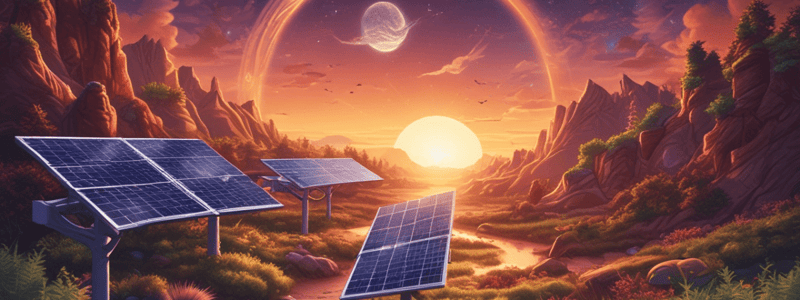Podcast
Questions and Answers
What would happen to the Earth if it didn't have the sun?
What would happen to the Earth if it didn't have the sun?
- It would become a planet full of water and fire
- It would be dark and freezing cold, without a living thing in sight (correct)
- It would turn into a giant ball of ice
- It would be a perfect place for humans to live
What is the term for the process by which plants make their own food?
What is the term for the process by which plants make their own food?
- Respiration
- Energy Transfer
- Food Chain
- Photosynthesis (correct)
What is the role of primary consumers in the food chain?
What is the role of primary consumers in the food chain?
- They eat plants and use the glucose for energy (correct)
- They are responsible for decomposing dead organisms
- They produce their own food through photosynthesis
- They are the top predators in the food chain
What happens to the energy that is not used by an animal in the food chain?
What happens to the energy that is not used by an animal in the food chain?
What is the main source of energy for all living things on Earth?
What is the main source of energy for all living things on Earth?
What type of consumer eats both plants and primary consumers?
What type of consumer eats both plants and primary consumers?
What is the energy source for secondary consumers?
What is the energy source for secondary consumers?
What type of consumer is an owl in the given example?
What type of consumer is an owl in the given example?
Why do food chains generally stop at the tertiary consumer level?
Why do food chains generally stop at the tertiary consumer level?
What is the role of top consumers in ecosystems?
What is the role of top consumers in ecosystems?
Flashcards are hidden until you start studying
Study Notes
The Importance of the Sun
- Without the sun, Earth would be dark, freezing cold, and devoid of life.
- The sun is the primary source of energy for all living things, and life on Earth would not be possible without it.
Food Chain Overview
- A food chain represents a series of organisms, each relying on the previous one for food.
- Energy is transferred from one living thing to another through a food chain.
Producers
- Producers, such as plants, make their own food through photosynthesis.
- Photosynthesis uses carbon dioxide, water, and sun energy to produce oxygen and glucose.
- Glucose is a crucial energy source for other organisms in the food chain.
- Producers are the first to receive energy from the sun, and a large number of them are necessary to support the rest of the food chain.
Primary Consumers
- Primary consumers, also known as herbivores, eat producers (plants).
- Examples of primary consumers include cows, giraffes, and rabbits.
- When primary consumers eat plants, they consume glucose and use it for energy.
- Excess energy is released into the atmosphere as heat.
Secondary and Tertiary Consumers
- As you move up the food chain, less energy is passed on to each level.
- Secondary consumers eat primary consumers and/or producers.
- Omnivores eat both plants and animals, while carnivores eat only animals.
- Examples of secondary consumers include bears, rats, and fish.
- Tertiary consumers eat secondary consumers, and are typically large, meat-eating predators.
- Examples of tertiary consumers include lions, sharks, owls, and humans.
- These top consumers use most of their energy, which is why food chains generally stop at this level.
- Top consumers play a crucial role in preventing overpopulation in ecosystems.
Studying That Suits You
Use AI to generate personalized quizzes and flashcards to suit your learning preferences.




